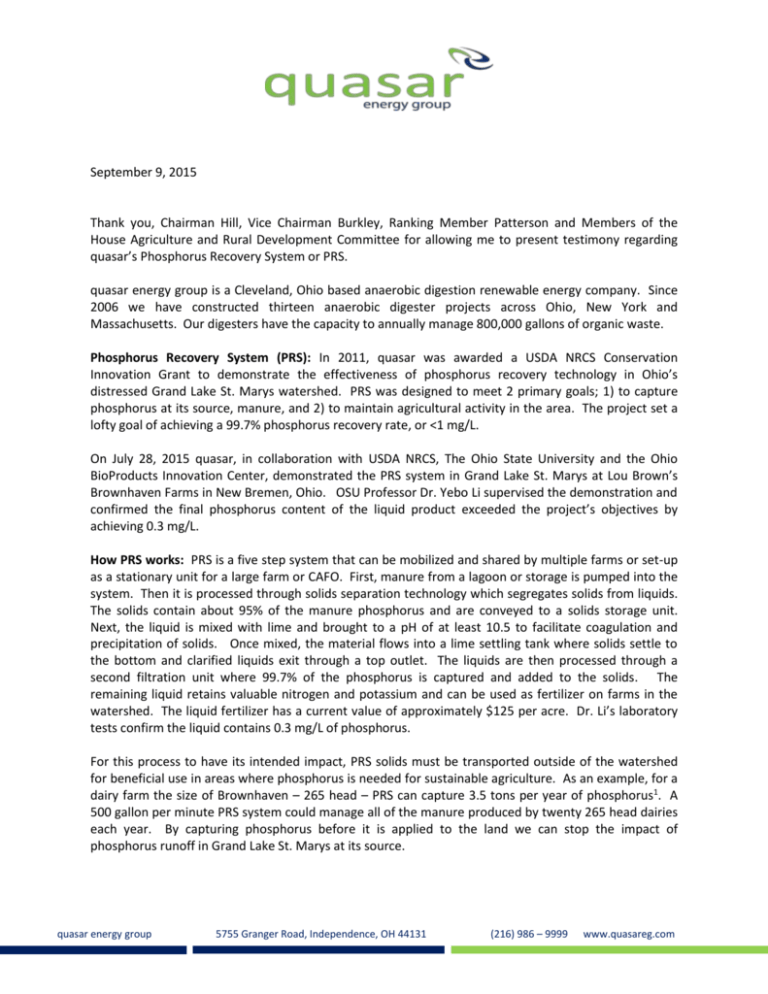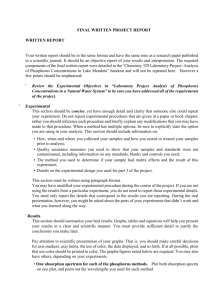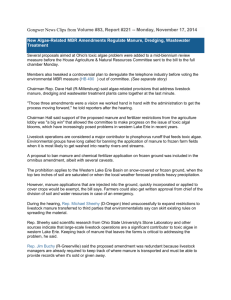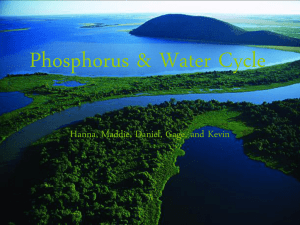September 9, 2015 Thank you, Chairman Hill, Vice Chairman
advertisement

September 9, 2015 Thank you, Chairman Hill, Vice Chairman Burkley, Ranking Member Patterson and Members of the House Agriculture and Rural Development Committee for allowing me to present testimony regarding quasar’s Phosphorus Recovery System or PRS. quasar energy group is a Cleveland, Ohio based anaerobic digestion renewable energy company. Since 2006 we have constructed thirteen anaerobic digester projects across Ohio, New York and Massachusetts. Our digesters have the capacity to annually manage 800,000 gallons of organic waste. Phosphorus Recovery System (PRS): In 2011, quasar was awarded a USDA NRCS Conservation Innovation Grant to demonstrate the effectiveness of phosphorus recovery technology in Ohio’s distressed Grand Lake St. Marys watershed. PRS was designed to meet 2 primary goals; 1) to capture phosphorus at its source, manure, and 2) to maintain agricultural activity in the area. The project set a lofty goal of achieving a 99.7% phosphorus recovery rate, or <1 mg/L. On July 28, 2015 quasar, in collaboration with USDA NRCS, The Ohio State University and the Ohio BioProducts Innovation Center, demonstrated the PRS system in Grand Lake St. Marys at Lou Brown’s Brownhaven Farms in New Bremen, Ohio. OSU Professor Dr. Yebo Li supervised the demonstration and confirmed the final phosphorus content of the liquid product exceeded the project’s objectives by achieving 0.3 mg/L. How PRS works: PRS is a five step system that can be mobilized and shared by multiple farms or set-up as a stationary unit for a large farm or CAFO. First, manure from a lagoon or storage is pumped into the system. Then it is processed through solids separation technology which segregates solids from liquids. The solids contain about 95% of the manure phosphorus and are conveyed to a solids storage unit. Next, the liquid is mixed with lime and brought to a pH of at least 10.5 to facilitate coagulation and precipitation of solids. Once mixed, the material flows into a lime settling tank where solids settle to the bottom and clarified liquids exit through a top outlet. The liquids are then processed through a second filtration unit where 99.7% of the phosphorus is captured and added to the solids. The remaining liquid retains valuable nitrogen and potassium and can be used as fertilizer on farms in the watershed. The liquid fertilizer has a current value of approximately $125 per acre. Dr. Li’s laboratory tests confirm the liquid contains 0.3 mg/L of phosphorus. For this process to have its intended impact, PRS solids must be transported outside of the watershed for beneficial use in areas where phosphorus is needed for sustainable agriculture. As an example, for a dairy farm the size of Brownhaven – 265 head – PRS can capture 3.5 tons per year of phosphorus1. A 500 gallon per minute PRS system could manage all of the manure produced by twenty 265 head dairies each year. By capturing phosphorus before it is applied to the land we can stop the impact of phosphorus runoff in Grand Lake St. Marys at its source. quasar energy group 5755 Granger Road, Independence, OH 44131 (216) 986 – 9999 www.quasareg.com Right now quasar’s engineering team is actively working on Phase II of PRS development which focuses on refining the system to enhance performance and further reduce costs. Phase II will deploy drying and gasification technology that would reduce the volume of solids that would be transported out of the watershed by converting them to a high nutrient, carbon negative biochar product. Affordable Solutions: Technology is one piece of the puzzle. Farmers in Grand Lake St. Marys need a solution they can afford to deploy across the entire watershed. The industry is presently looking for encouragement from the legislature to deploy technology solutions. Funding must be made available to facilitate broad adoption of nutrient management solutions in distressed watersheds. Refundable income tax credits, like Chairman Hill’s H.B. 297, facilitate compliance with S.B. 1 and should be expanded to apply to PRS by adding “nutrient separation” into the definition of “manure storage or treatment facility” and should be made accessible to technology providers and co-operatives. Other options for state participation include expanding the low interest loans available through Ohio EPA’s Water Pollution Control Loan Fund to agriculture, small businesses and technology providers. And finally, the state should actively support expanding USDA’s EQIP program to include nutrient separation technology. A new organization, Newtrient, LLC, has been formed to facilitate coupling agriculture with funding mechanisms to bring technology to the farm where it is needed most. Newtrient was formed by dairy cooperatives across the country representing more than 20,000 farms of all sizes and more than half the milk produced in the country. Newtrient’s mission is to reduce the environmental footprint of dairy operations while sustaining or growing the economic value that we know is embedded within the manure. The BIG Picture: The impact of algae blooms from phosphorus overloading spreads beyond GLSM and threatens one of Ohio’s most valuable natural resources – Lake Erie. US Geological Survey (USGS) identifies sewage as the largest contributor to Lake Erie’s algae blooms. According to the U.S. Geological Survey’s most recent data2, the origins of phosphorus in Lake Erie are as follows: Sewage: 46.1% Urban Land: 12.9% Agriculture: 36.6% (breakdown below) Farm Fertilizer: 22.0% Manure (Confined Animals): 12.9% Manure (Unconfined Animals): 1.7% Forest/Wetland: 4.1% For example, nine wastewater treatment plants discharge into Grand Lake or a direct tributary. With statistics illustrating that sewage contributes 46.1% of the phosphorus to Lake Erie it is clear that a collaborative initiative between agriculture and wastewater must ensue to resolve the problem. PRS can be deployed in agricultural settings and at wastewater treatment plants – a solution for addressing the source of the two primary contributors to the algae challenge. Conclusion: PRS efficiently manages phosphorus from municipal sludge and manure before it enters the watershed and provides stakeholders with options to decide how and where solids will be appropriately used. Thank you for allowing me to offer this testimony regarding our Phosphorus Recovery System. I would be pleased to address any questions at this time. Mel Kurtz Page | 2 President References: 1. Calculated using OSU Manure Management Bulletin average dairy cow/day P2O5 production @ 265 head. 2. USGS more information available here Notes: a) the data for point sources is from 2002, it will be updated with 2012 numbers within the next 1.5 years, and b) only reports data for what enters Lake Erie from the United States Page | 3





